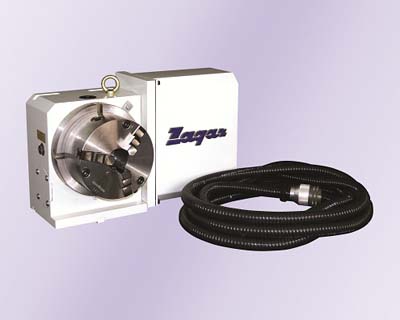
Zagar Workholding Group has added a complete line of rotary and indexing tables to its product offering. Sold under the Zagar brand, the tables are available in various diameters and with right hand or back-mounted AC or DC motors. Standard table diameters range from 4.72 to 12.6 inches (120mm — 320mm). Special large size tables are available up to 117 inches.
All Zagar tables feature the following:
Auto home positioning and pneumatic brake systems
Precision bronze/nickel worm wheel and case hardened steel worm gear to insure long term indexing accuracy (specifications conform to the Japan Gear Association)
Dual pitch worm shaft that allows easy backlash adjustment
One piece faceplate and spindle design for maximum rigidity
Gear ratio of 90:1 provides high speed feed rate Available back mount motor design to accommodate minimum mounting space in small drilling and tapping CNC machining centers
Zagar tables are compatible with various models of servo motors and can be integrated with most 4th and 5th axis CNC controls. Zagar can also provide an American-made indexing controller that functions with any CNC or manual machine tool. The controller uses industry standard G-code programming and can be actuated via an RS-232 control signal.
Contact Details
Related Glossary Terms
- G-code programming
G-code programming
Programs written to operate NC machines with control systems that comply with the ANSI/EIA RS-274-D-1980 Standard. A program consists of a series of data blocks, each of which is treated as a unit by the controller and contains enough information for a complete command to be carried out by the machine.
- backlash
backlash
Reaction in dynamic motion systems where potential energy that was created while the object was in motion is released when the object stops. Release of this potential energy or inertia causes the device to quickly snap backward relative to the last direction of motion. Backlash can cause a system’s final resting position to be different from what was intended and from where the control system intended to stop the device.
- centers
centers
Cone-shaped pins that support a workpiece by one or two ends during machining. The centers fit into holes drilled in the workpiece ends. Centers that turn with the workpiece are called “live” centers; those that do not are called “dead” centers.
- computer numerical control ( CNC)
computer numerical control ( CNC)
Microprocessor-based controller dedicated to a machine tool that permits the creation or modification of parts. Programmed numerical control activates the machine’s servos and spindle drives and controls the various machining operations. See DNC, direct numerical control; NC, numerical control.
- feed
feed
Rate of change of position of the tool as a whole, relative to the workpiece while cutting.
- pitch
pitch
1. On a saw blade, the number of teeth per inch. 2. In threading, the number of threads per inch.
- tapping
tapping
Machining operation in which a tap, with teeth on its periphery, cuts internal threads in a predrilled hole having a smaller diameter than the tap diameter. Threads are formed by a combined rotary and axial-relative motion between tap and workpiece. See tap.






